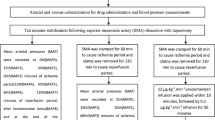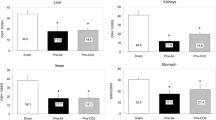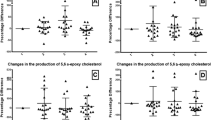Abstract
Background
Pneumoperitoneum (PP), established for laparoscopic (LPS) operation, has been associated with potential detrimental effects, such as mesenteric ischemia–reperfusion injury. The objective of the trial was to measure intestinal tissue oxygen pressure (PtiO2) and oxidative damage during laparoscopic (LPS) and open colon surgery and during the postoperative course.
Methods
Forty patients candidate to left-sided colectomy were randomized to undergo open or LPS resection (20 patients/group). During the operation, PtiO2 was measured at established changes of PP pressure (from 0–15 mmHg) and for 6 days postoperatively. PtiO2 was determined by a polarographic microprobe implanted in the colon wall. Ischemia–reperfusion injury was assessed by plasma malondialdehyde (MDA). ClinicalTrial.gov registration number: NCT01040013.
Results
LPS was associated with a higher PtiO2 at the beginning of surgery (73.9 ± 9.4 vs. 64.3 ± 6.4 in open; P = 0.04) and at the end of the operation (57.7 ± 7.9 vs. 53.1 ± 4.7 in open; P = 0.03). PtiO2 decreased significantly during mesentery traction vs. beginning in both groups (respectively 58.7 ± 13.2 vs. 73.9 ± 9.4 in LPS and 55.3 ± 6.4 vs. 64.3 ± 6.4 in open group; minimum P = 0.02). During LPS, there was a significant decrease of PtiO2 only when PP was increased to 15 mmHg (63.2 ± 7.5 vs. 76.6 ± 10.7 at 10 mmHg; P = 0.03). PtiO2 also was significantly better in the LPS group during the first 3 days after operation (minimum P = 0.04 vs. open). MDA significantly increased in both groups after mesentery traction and at the end of operation vs. baseline levels with no difference between techniques.
Conclusions
LPS seems to be associated with a better intra- and postoperative PtiO2. High-pressure PP may impair PtiO2.





Similar content being viewed by others

References
Falk PM, Beart RW, Wexner SD, Thorson AG, Jagelman DG, Lavery IC, Johansen OB, Fitzgibbons RJ Jr (1993) Laparoscopic colectomy a critical appraisal. Dis Colon Rectum 36:28–34
Monson JRT, Darzi A, Carey PD, Guillou PJ (1992) Prospective evaluation of laparoscopic-assisted colectomy in an unselected group of patients. Lancet 340:831–833
Braga M, Vignali A, Zuliani W, Radaelli G, Gianotti L, Toussoun G, Di Carlo V (2002) Training period in laparoscopic colorectal surgery. A case-matched comparative study with open surgery. Surg Endosc 16:31–35
Kehlet H, Nielsen HJ (1998) Impact of laparoscopic surgery on stress response, immunofunction and risk of infectious complications. New Horizon 6:S80–S88
Schwenk W, Haase O, Neudecker JJ, Müller JM (2005) Short-term benefits for laparoscopic colorectal resection. Cochrane Database Syst Rev 2:CD003145. doi:10.1002/14651858.CD003145.pub2
Braga M, Vignali A, Zuliani W, Radaelli G, Gianotti L, Martani C, Toussoun G, Di Carlo V (2002) Metabolic and functional results after laparoscopic colorectal surgery. A randomized, controlled trial. Dis Colon Rectum 45:1070–1077
Braga M, Vignali A, Gianotti L, Zuliani W, Radaelli G, Granin P, Dellabona P, Di Carlo V (2002) Laparoscopic versus open colorectal surgery. A randomized trial on short-term outcome. Ann Surg 236:759–767
Klarenbeek BR, Veenhof AA, Bergamaschi R, van der Peet DL, van den Broek WT, de Lange ES, Bemelman WA, Heres P, Lacy AM, Engel AF, Cuesta MA (2009) Laparoscopic sigmoid resection for diverticulitis decreases major morbidity rates: a randomized control trial. Short-term results of the sigma trial. Ann Surg 249:39–44
Braga M, Vignali A, Zuliani W, Frasson M, Di Serio C, Di Carlo V (2005) Laparoscopic versus open colorectal surgery. Cost-benefit analysis in a single-center randomized trial. Ann Surg 242:890–896
Lacy AM, Garcia-Valdecasas JC, Delgado S, Castells A, Taurá P, Piqué JM, Visa J (2002) Laparoscopy-assisted colectomy versus open colectomy for treatment of non-metastatic colon cancer: a randomised trial. Lancet 359:2224–2229
Leung KL, Kwok SP, Lam SC, Lee JF, Yiu RY, Ng SS, Lai PB, Lau WY (2004) Laparoscopic resection of rectosigmoid carcinoma: prospective randomised trial. Lancet 363:1187–1192
COST Study Group (2004) A comparison of laparoscopically assisted and open colectomy for colon cancer. N Engl J Med 350:2050–2059
Kuhry E, Schwenk W, Gaupset R et al (2008) Long-term results of laparoscopic colorectal cancer resection. Cochrane Database Syst Rev 2:CD003432. doi:10.1002/14651858.CD003432.pub2
Braga M, Frasson M, Vignali A, Zuliani W, Civelli V, Di Carlo V (2005) Laparoscopic vs. open colectomy in cancer patients: long-term complications, quality of life, and survival. Dis Colon Rectum 48:2217–2223
Transatlantic Laparoscopically Assisted vs. Open Colectomy Trials Group (2007) Laparoscopically assisted vs open colectomy for colon cancer. Arch Surg 142:298–303
Jayne DG, Guillou PJ, Thorpe H, Quirke P, Copeland J, Smith AM, Heath RM, Brown JM (2007) Randomized trial of laparoscopic-assisted resection of colorectal carcinoma: 3-year results of the UK MRC CLASICC trial group. J Clin Oncol 25:3061–3068
Zhu Q, Mao Z, Yu B, Jin J, Zheng M, Li J (2009) Effects of persistent CO2 insufflation during different laparoscopic inguinal hernioplasty: a prospective, randomized, controlled study. J Laparoendosc Adv Surg Tech A 19:611–614
Maracajá-Neto LF, Verçosa N, Roncally AC, Giannella A, Bozza FA, Lessa MA (2009) Beneficial effects of high positive end-expiratory pressure in lung respiratory mechanics during laparoscopic surgery. Acta Anaesthesiol Scand 53:210–217
Sammour T, Mittal A, Loveday BPT, Kahokehr A, Phillips AR, Windsor JA, Hill AG (2009) Systematic review of oxidative stress associated with pneumoperitoneum. Br J Surg 96:836–850
Schaeffer M, Kraehenbuehl L (2001) Effect of laparoscopy on intra-abdominal blood flow. Surgery 29:385–389
Bandyopadhyay D, Kapadia CR (1993) Large bowel ischemia following laparoscopic inguinal hernioplasty. Surg Endosc 17:520–521
Wassenaar EB, Raymakers JT, Rakic S (2007) Fatal intestinal ischemia after laparoscopic correction of incisional hernia. JSLS 11:389–393
Paul A, Troidl H, Peters S, Stuttmenn R (1994) Fatal intestinal ischaemia following laparoscopic cholecystectomy. Br J Surg 81:1207
Talbot D, Miller IT, Miller IA (1995) Fatal intestinal ischaemia following laparoscopic cholecystectomy. Br J Surg 82:1143
Ozmen MM, Kessaf Aslar A, Besler HT, Cinel I (2002) Does splanchnic ischemia occur during laparoscopic cholecystectomy? Surg Endosc 16:468–471
Schilling MK, Redaelli C, Kraehenbuehl L, Signer C, Büchler MW (1997) Splanchnic microcirculation changes during CO2 laparoscopy. J Am Coll Surg 184:378–382
Jakimowicz J, Stultiens G, Smulders F (1998) Laparoscopic insufflation of the abdomen reduces portal venous flow. Surg Endosc 12:129–132
Fleischmann E, Kugener A, Kabon B, Kimberger O, Herbst F, Kurz A (2007) Laparoscopic surgery impairs tissue oxygen tension more than open surgery. Br J Surg 94:362–368
Jacobi CA, Zieren HU, Mullen JM, Adili F, Pichlmaier H (1996) Anastomotic tissue oxygen tension during esophagectomy in patients with esophagus carcinoma. Eur Surg Res 28:26–31
Grune T, Berger MM (2007) Markers of oxidative stress in ICU clinical settings: present and future. Curr Opin Clin Nutr Metab Care 10:712–717
Templer J, Kon SP, Milligan TP, Newman DJ, Raftery MJ (1999) Increased plasma malondialdehyde levels in glomerular disease as determined by a fully validated HPLC method. Nephrol Dial Transplant 14:946–951
Braga M, Gianotti L, Gentilini O, Parisi V, Salis C, Di Carlo V (2001) Early postoperative enteral nutrition improves gut oxygenation and reduces costs compared with total parenteral nutrition. Crit Care Med 29:242–248
Bickel A, Drobot A, Aviram M, Eitan A (2007) Validation and reduction of the oxidative stress following laparoscopic operations. A prospective randomized controlled study. Ann Surg 246:31–35
Singh DB, Stansby G, Bain I, Harrison DK (2009) Intraoperative measurement of colonic oxygenation during bowel resection. Adv Exp Med Biol 645:261–266
Vignali A, Gianotti L, Braga M, Radaelli G, Malvezzi L, Di Carlo V (2000) Altered microperfusion at the rectal stump is predictive for rectal anastomotic leak. Dis Colon Rectum 43:76–82
West JM (1990) The surgical patient: influence of the perioperative stress response on perfusion. AACN Clin Issues Crit Care Nurs 3:595–601
Ba ZF, Lu A, Shimizu T, Szalay L, Schwacha MG, Rue LW III, Bland KI, Chaudry IH (2007) 17β-Estradiol modulates vasoconstriction induced by endothelin-1 following trauma-hemorrhage. Am J Physiol Heart Circ Physiol 292:H245–H250
Ba ZF, Wang P, Koo DJ, Cioffi WG, Bland KI, Chaudry IH (2000) Alterations in tissue oxygen consumption and extraction after trauma and hemorrhagic shock. Crit Care Med 28:2837–2842
Nagaraj S, Gabrilovich DI (2008) Tumor escape mechanism governed by myeloid-derived suppressor cells. Cancer Res 68:2561–2563
Rodríguez PC, Ochoa AC (2006) T-cell dysfunction in cancer: role of myeloid cells and tumor cells regulating amino acid availability and oxidative stress. Semin Cancer Biol 16:66–72
Huycke MM, Gaskin HR (2004) Commensal bacteria, redox stress, and colorectal cancer: mechanisms and models. Exp Biol Med 229:586–597
Shakhar G, Ben-Eliyahu S (2003) Potential prophylactic measures against postoperative immunosuppression: could they reduce recurrence rates in oncological patients? Ann Surg Oncol 10:972–992
Whitson BA, D’Cunha J, Maddaus MA (2007) Minimally invasive cancer surgery improves patient survival rates through less perioperative immunosuppression. Med Hypoth 68:1328–1332
van der Bij GJ, Oosterling SJ, Beelen RHJ, Meijer S, Coffey JC, van Egmond M (2009) The perioperative period is an underutilized window of therapeutic opportunity in patients with colorectal cancer. Ann Surg 249:727–734
Mattei P, Rombeau JL (2006) Review of the pathophysiology and management of postoperative ileus. World J Surg 30:1382–1391
Widner B, Wirleitner B, Baier-Bitterlich G, Weiss G, Fuchs D (2000) Cellular immune activation, neopterin production, tryptophan degradation and the development of immunodeficiency. Arch Immunol Ther Exp 48:251–258
Scannell G (1996) Leukocyte responses to hypoxic/ischemic conditions. New Horizon 4:179–183
Fukatsu K, Sakamoto S, Hara E, Ueno C, Maeshima Y, Matsumoto I, Mochizuki H, Hiraide H (2006) Gut ischemia-reperfusion affects gut mucosal immunity: a possible mechanism for infectious complications after severe surgical insults. Crit Care Med 34:182–187
Rahman SH, Ammori BJ, Holmfield J, Larvin M, McMahon MJ (2003) Intestinal hypoperfusion contributes to gut barrier failure in severe acute pancreatitis. J Gastrointest Surg 7:26–35
Gianotti L, Alexander JW, Fukushima R, Childress CP (1993) Translocation of Candida albicans is related to the blood flow of individual intestinal villi. Circ Shock 40:250–257
Unno N, Wang H, Menconi MJ, Tytgat SH, Larkin V, Smith M, Morin MJ, Chavez A, Hodin RA, Fink MP (1997) Inhibition of inducible nitric oxide synthase ameliorates endotoxin-induced gut mucosal barrier dysfunction in rats. Gastroenterology 113:1246–1257
Gianotti L, Braga M, Vignali A, Balzano G, Zerbi A, Bisagni P, Di Carlo V (1997) Effect of route of delivery and formulation of postoperative nutritional support in patients undergoing major operations for malignancy. Arch Surg 132:1222–1230
Neuhaus SJ, Watson DI (2004) Pneumoperitoneum and peritoneal surface changes: a review. Surg Endosc 18:1316–1322
Ishizaki Y, Bandai Y, Shimomura K, Abe H, Ohtomo Y, Idezuki Y (1993) Changes in splanchnic blood flow and cardiovascular effects following peritoneal insufflation of carbon dioxide. Surg Endosc 7:420–423
Sammour T, Kahokehr A, Hill AG (2008) Meta-analysis of the effect of warm humidified insufflation on pain after laparoscopy. Br J Surg 95:950–956
Yilmaz S, Polat C, Kahraman A, Koken T, Arikan Y, Dilek ON, Gökçe O (2004) The comparison of the oxidative stress effects of different gases and intra-abdominal pressures in an experimental rat model. J Laparoendosc Adv Surg Tech A 14:165–168
Stewart BT, Stitz RW, Tuch MM, Lumley JW (1999) Hypothermia in open and laparoscopic colorectal surgery. Dis Colon Rectum 42:1292–1295
Kurz A, Sessler DI, Lenhardt R (1996) Perioperative normothermia to reduce the incidence of surgical wound-infection and shorten hospitalization. N Engl J Med 334:1209–1215
Acknowledgments
The study was supported by a grant of the Milano-Bicocca University (Fondo di Ateneo per la Ricerca 2008). The trial was registered at ClinicalTrial.gov with the ID number NCT01040013.
Disclosures
Drs. Luca Gianotti, Luca Nespoli, Simona Rocchetti, Andrea Vignali, Angelo Nespoli, and Marco Braga have no conflicts of interest or financial ties to disclose.
Author information
Authors and Affiliations
Corresponding author
Rights and permissions
About this article
Cite this article
Gianotti, L., Nespoli, L., Rocchetti, S. et al. Gut oxygenation and oxidative damage during and after laparoscopic and open left-sided colon resection: a prospective, randomized, controlled clinical trial. Surg Endosc 25, 1835–1843 (2011). https://doi.org/10.1007/s00464-010-1475-2
Received:
Accepted:
Published:
Issue Date:
DOI: https://doi.org/10.1007/s00464-010-1475-2



